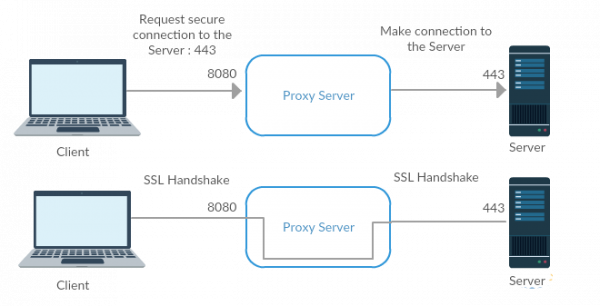Ssl tunnel
You want to be able to access some restricted destinations and/or ports with some applications from your computer but you are on a restricted network (corporate) - Even using a Torrent client.
How to overcome this limitation?
What if backend service is secure one?
We can use SSL tunneling for overcome above issue.
What is the SSL Tunneling?
SSL tunneling is when an Internal client application requests a web object using HTTPS on port 8080 through the proxy server.
An example of this is when you are using online shopping. The internet connection to the target relevant e-commerce website is tunneled to by you through proxy server. The key word here is through. The client communicates with the target web server directly after the initial connection has been established by proxy server, by means of communication within the SSL tunnel that has been created after SSL negotiation has taken place.
How it's Working?
The client makes a tunneling request: CONNECT server-host-name:port HTTP/1.1 (or HTTP/1.0). The port number is optional and is usually 443. The client application will automatically send the CONNECT request to the proxy server first for every HTTPS request if the forward proxy is configured in the browser.
CONNECT www.example.com:443 HTTP/1.1
Host: www.example.com:443
- RFC 2616 treats CONNECT as a way to establish a simple tunnel. There is more about it in RFC 2817, although the rest of RFC 2817 (upgrades to TLS within a non-proxy HTTP connection) is rarely used.
- The proxy accepts the connection on its port 8080, receives the request, and connects to the destination server on the port requested by the client.
- The proxy replies to the client that a connection is established with the 200 OK response.
- After this, the connection between the client and the proxy server is kept open. The proxy server relays everything on the client-proxy connection to and from proxy-backend. The client upgrades its active (proxy-backend) connection to an SSL/TLS connection, by initiating a TLS handshake on that channel.Since everything is now relayed to the backend server, it's as if the TLS exchange was done directly withwww.example.com:443.The proxy server doesn't play any role in the handshake. The TLS handshake effectively happens directly between the client and the backend server.
- After the secure handshake is completed, the proxy sends and receives encrypted data to be decrypted at the client or at the destination server.
- If the client or the destination server requests a closure on either port, the proxy server closes both connections (ports 443 and 8080) and resumes its normal activity.

